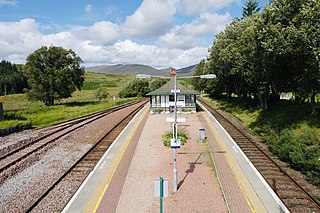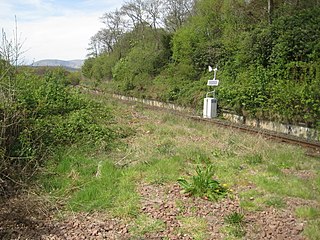
A railroad switch (AE), turnout, or [set of] points (BE) is a mechanical installation enabling railway trains to be guided from one track to another, such as at a railway junction or where a spur or siding branches off.
A passing loop or passing siding is a place on a single line railway or tramway, often located at or near a station, where trains or trams travelling in opposite directions can pass each other. Trains/trams going in the same direction can also overtake, provided that the signalling arrangement allows it. A passing loop is double-ended and connected to the main track at both ends, though a dead end siding known as a refuge siding, which is much less convenient, can be used. A similar arrangement is used on the gauntlet track of cable railways and funiculars, and in passing places on single-track roads.

The Felixstowe branch line is a railway branch line in Suffolk, England, that connects the Great Eastern Main Line to Felixstowe and its port.

Catch points and trap points are types of turnout which act as railway safety devices. Both work by guiding railway carriages and trucks from a dangerous route onto a separate, safer track. Catch points are used to derail vehicles which are out of control on steep slopes. Trap points are used to protect main railway lines from unauthorised vehicles moving onto them from sidings or branch lines. Either of these track arrangements may lead the vehicles into a sand drag or safety siding, track arrangements which are used to safely stop them after they have left the main tracks.

Bodmin Parkway railway station is on the Cornish Main Line that serves the nearby town of Bodmin and other parts of mid-Cornwall, England. It is situated 3 miles (4.8 km) south-east of the town of Bodmin in the civil parish of St Winnow, 274 miles 3 chains from London Paddington measured via Box and Plymouth Millbay.

Hamilton railway station is a heritage-listed railway station on the Newcastle line in the inner Newcastle suburb of Hamilton in New South Wales, Australia. It was added to the New South Wales State Heritage Register on 2 April 1999.

Rannoch railway station, on the West Highland Line, serves the area of Rannoch in Perth and Kinross, Scotland. In 2017, Simon Jenkins reported it to be one of the best 10 stations in Britain. It is situated between Corrour and Bridge of Orchy, 64 miles 36 chains (103.7 km) from Craigendoran Junction, near Helensburgh. ScotRail manage the station and operate most services, along with Caledonian Sleeper.

Bridge of Orchy railway station is a railway station in the village of Bridge of Orchy in the west of Scotland. The station is on the West Highland Line, between Rannoch and Upper Tyndrum, 48 miles 68 chains (78.6 km) from Craigendoran Junction, near Helensburgh. ScotRail manage the station and operate most services, with others provided by Caledonian Sleeper.

Spean Bridge railway station is a railway station serving the village of Spean Bridge in the Highland region of Scotland. This station is on the West Highland Line, between Roy Bridge and Fort William, sited 90 miles 56 chains (146 km) from Craigendoran Junction, near Helensburgh. ScotRail manage the station and operate most services, along with Caledonian Sleeper.

The West Highland Railway was a railway company that constructed a railway line from Craigendoran to Fort William and Mallaig. The line was built through remote and difficult terrain in two stages: the section from Craigendoran to Fort William opened in 1894, with a short extension to Banavie on the Caledonian Canal opening in 1895.
The Didcot, Newbury and Southampton Railway (DN&SR) was a cross-country railway running north–south between Didcot, Newbury and Winchester. Its promoters intended an independent route to Southampton and envisaged heavy traffic from the Midlands and North of England to the port, but they ran out of funds to complete the line to Southampton. The intended heavy through traffic never materialised, and the line was dependent on larger railways—the Great Western Railway and the London and South Western Railway—for support, which was not freely given. The line opened in two stages, in 1882 and 1885.

Rhu is a closed railway station located in the village of Rhu, in Argyll and Bute, Scotland, on the east shore of Gare Loch. It is located towards the southern end of the West Highland Railway.

Shandon is a closed railway station located at Shandon on the east shore of Gare Loch, in Argyll and Bute. It is located towards the southern end of the West Highland Railway.
The Mont Park railway is a former branch line from the Hurstbridge line in Melbourne, Australia. The main line connection was at the up (Melbourne) end of Macleod station, with the line operating between 1911 and 1964.
The Buckie and Portessie Branch was a railway branch line in Scotland, built by the Highland Railway to serve an important fishing harbour at Buckie, in Banffshire. It connected with the rival Great North of Scotland Railway at Portessie.

The Signals, Crane and Subway are heritage-listed railway infrastructure at Charters Towers railway station, Enterprise Road, Charters Towers, Charters Towers Region, Queensland, Australia. They were added to the Queensland Heritage Register on 30 October 2008.
Inveruglas was a remote temporary private railway station near the hamlet of Inveruglas, Argyll and Bute, Scotland. Opened in 1945 by the LNER, it was built in connection with the construction of the Sloy Hydro-Electric facility and was located on the Ardlui side of the Inveruglas Viaduct and recorded to be out of use by around 1948.

Whistlefield, later Whistlefield Halt, was a minor station on the West Highland Line 10.30 miles from Craigendoran Junction railway station near the hamlet of Portincaple on Loch Long, Argyll and Bute, Scotland. Opened in 1896 by the West Highland Railway, it was built on a single track section without a passing loop in between Garelochhead and Glen Douglas and closed by the British Railways Board in 1964.
Faslane Platform railway station or Faslane Junction Platform railway station was a temporary private railway station located near the Stuckendoff PoW camp, Shandon, Argyll and Bute, Scotland. Opened in 1945 by the LNER in connection with the construction of the Loch Sloy Hydro-Electric facility and was located on the Shandon side of the Chapel Burn and recorded to be out of use by around 1949 in the British Railways era.

Bishopsbourne was a station on the Elham Valley Railway. It opened in 1889 and closed to passengers in 1940 and freight in 1947.













